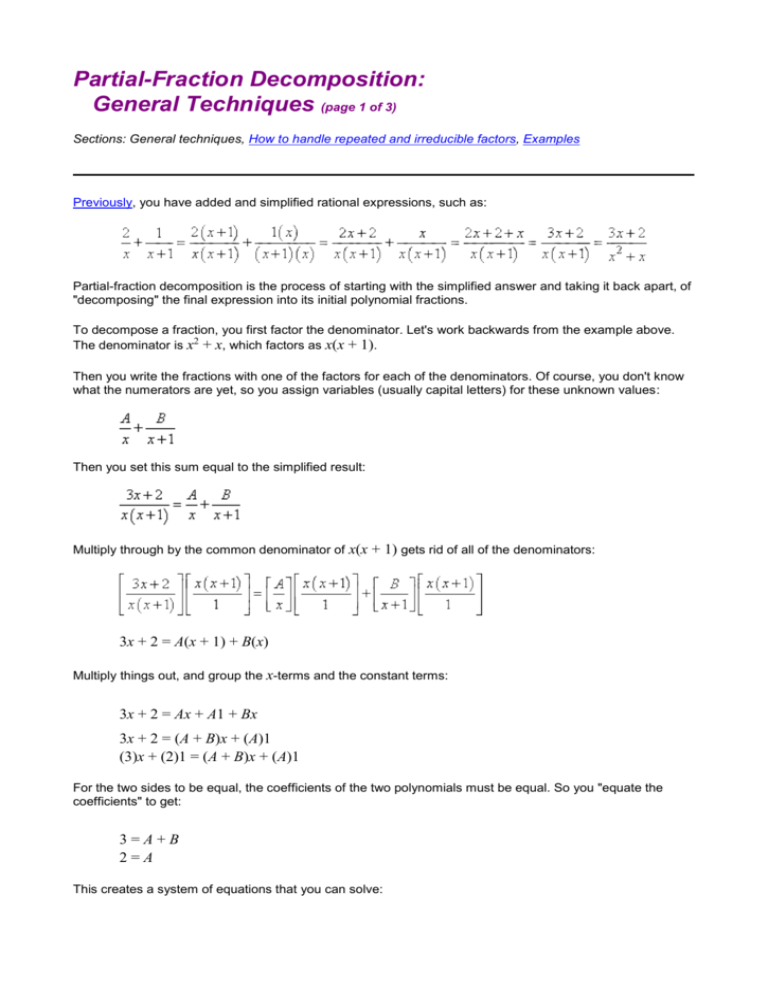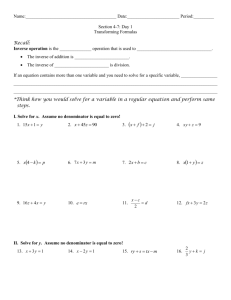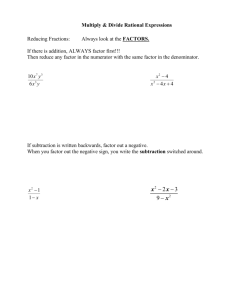
Partial-Fraction Decomposition:
General Techniques (page 1 of 3)
Sections: General techniques, How to handle repeated and irreducible factors, Examples
Previously, you have added and simplified rational expressions, such as:
Partial-fraction decomposition is the process of starting with the simplified answer and taking it back apart, of
"decomposing" the final expression into its initial polynomial fractions.
To decompose a fraction, you first factor the denominator. Let's work backwards from the example above.
The denominator is x2 + x, which factors as x(x + 1).
Then you write the fractions with one of the factors for each of the denominators. Of course, you don't know
what the numerators are yet, so you assign variables (usually capital letters) for these unknown values:
Then you set this sum equal to the simplified result:
Multiply through by the common denominator of
3x + 2 = A(x + 1) + B(x)
x(x + 1) gets rid of all of the denominators:
Copyright © Elizabeth Stapel 2006-2011 All Rights Reserved
Multiply things out, and group the x-terms and the constant terms:
3x + 2 = Ax + A1 + Bx
3x + 2 = (A + B)x + (A)1
(3)x + (2)1 = (A + B)x + (A)1
For the two sides to be equal, the coefficients of the two polynomials must be equal. So you "equate the
coefficients" to get:
3=A+B
2=A
This creates a system of equations that you can solve:
ADVERTISEMENT
A=2
B=1
Then the original fractions were (as we already know) the
following:
There is another method for solving for the values of A and B. Since the equation "3x + 2 = A(x + 1)
+ B(x)" is supposed to be true for any value of x, we can pick useful values of x, plug-n-chug, and find the
values for A and B. Looking at the equation "3x + 2 = A(x + 1) + B(x)", you can see that, if x = 0, then we
quickly find that 2 = A:
3x + 2 = A(x + 1) + B(x)
3(0) + 2 = A(0 + 1) + B(0)
0 + 2 = A(1) + 0
2=A
And if x = –1, then we easily get –3
+ 2 = –B, so B = 1.
I've never seen this second method in textbooks, but it can often save you a whole lot of time over the
"equate the coefficients and solve the system of equations" method that they usually teach.
If the denominator of your fraction factors into unique linear factors, then the decomposition process is fairly
straightforward, as shown in the previous example. But what if the factors aren't unique or aren't linear?
Sometimes a factor in the denominator occurs more than one. For instance, in the fraction 13/24, the
denominator 24 factors as 2×2×2×3. The factor 2 occurs three times. To get the13/24, there may have been
a 1/2 or a 1/4 or a1/8 that was included in the original addition. You can't tell by looking at the final result.
In the same way, if a rational expression has a repeated factor in the denominator, you can't tell, just by
looking, which denominators might have been included in the original addition. You have to account for every
possibility.
Find the partial-fraction decomposition of the following expression:
The factor x – 1 occurs three times in the denominator. I will account for that by forming fractions
containing increasing powers of this factor in the denominator, like this:
Now I multiply through by the common denominator to get:
x2 + 1 = Ax(x – 1)2 + Bx(x – 1) + Cx + D(x – 1)3
I could use a system of equations to solve for A, B,
The two zeroing numbers are x = 1 and x = 0: so
C, and D, but the other method seemed easier.
x = 1: 1 + 1 = 0 + 0 + C + 0, so C = 2
x = 0: 1 = 0 + 0 + 0 – D, so D = –1
But what do I do now? I have two other variables, namely A and B, for which I need values. But
since I've got values for C and D, I can pick any two other x-values, plug them in, and get a system
of equations that I can solve for A and B. The particular x-values I choose aren't important, so I'll
pick smallish ones:
x = 2:
Copyright © Elizabeth Stapel 2006-2011 All Rights Reserved
(2)2 + 1 = A(2)(2 – 1)2 + B(2)(2 – 1) + (2)(2) + (–1)(2 – 1)3
4 + 1 = 2A + 2B + 4 – 1
5 = 2A + 2B + 3
1=A+B
x = –1:
(–1)2 + 1 = A(–1)(–1 – 1)2 + B(–1)(–1 – 1) + (2)(–1) + (–1)(–1 – 1)3
1 + 1 = –4A + 2B – 2 + 8
2 = –4A + 2B + 6
2A – B = 2
I'm still stuck solving a system of equations, but by using the easier method to solve for C andD, I
now have a simpler system to solve. Adding the two equations, I get 3A = 3, so A = 1. Then B =
0 (so that term in the expansion "vanishes"), and the complete decomposition is:
In the above example, one of the coefficients turned out to be
zero. This doesn't happen often (in algebra classes, anyway),
but don't be surprised if you get zero, or even fractions, for some
of your coefficients. The textbooks usually stick pretty closely to
nice neat whole numbers, but not always. Don't just assume that
a fraction or a zero is a wrong answer. For instance:
ADVERTISEMENT
...decomposes as:
Note: You can also handle the fractions like this:
If the denominator of your rational expression has an unfactorable quadratic, then you have to account for
the possible "size" of the numerator. If the denominator contains a degree-two factor, then the numerator
might not be just a number; it might be of degree one. So you would deal with a quadratic factor in the
denominator by including a linear expression in the numerator.
Find the partial-fraction decomposition of the following:
Factoring the denominator, I get x(x2
look like this:
Note that the numerator for the "x2
+ 3). I can't factor the quadratic bit, so my expanded form will
+ 3" fraction is a linear polynomial, not just a constant term.
Multiplying through by the common denominator, I get:
x – 3 = A(x2 + 3) + (Bx + C)(x)
x – 3 = Ax2 + 3A + Bx2 + Cx
x – 3 = (A + B)x2 + (C)x + (3A)
The only zero in the original denominator is x = 0, so:
(0) – 3 = (A + B)(0)2 + C(0) + 3A
–3 = 3A
Then A = –1. Since I have no other helpful x-values to work with, I think I'll take the one value I've
solved for, equate the remaining coefficients, and see what that gives me:
x – 3 = (–1 + B)x2 + (C)x – 3
–1 + B = 0 and C = 1
B = 1 and C = 1
(There is no one "right" way to solve for the values of the coefficients. Use whichever method "feels"
right to you on a given exercise.)
Then the decomposition is:
If the denominator of your rational expression has repeated unfactorable quadratics, then you use linearfactor numerators and follow the pattern that we used for repeated linear factors in the denominator; that is,
you'll use fractions with increasing powers of the repeated factors in the denominator.
Set up, but do not solve, the decomposition equality for the following:
Since x2 + 1 is not factorable, I'll have to use numerators with linear factors. Then the decomposition
set-up looks like this:
Thankfully, I don't have to try to solve this one.
One additional note: Partial-fraction decomposition only works for "proper" fractions. That is, if the
denominator's degree is not larger than the numerator's degree (so you have, in effect, an "improper"
polynomial fraction), then you first have to use long division to get the "mixed number" form of the rational
expression. Then decompose the remaining fractional part.
Decompose the following:
Copyright © Elizabeth Stapel 2006-2011 All Rights Reserved
The numerator is of degree 5; the denominator is of degree 3. So first I have to do the long division:
The long division rearranges the rational expression to give me:
Now I can decompose the fractional part. The denominator factors as
The x2
+ 1 is irreducible, so the decomposition will be of the form:
(x2 + 1)(x – 2).
Multiplying out and solving, I get:
2x2 + x + 5 = A(x2 + 1) + (Bx + C)(x – 2)
x = 2: 8 + 2 + 5 = A(5) + (2B + C)(0), 15 = 5A, and A = 3
x = 0: 0 + 0 + 5 = 3(1) + (0 + C)(0 – 2),
5 = 3 – 2C, 2 = –2C, and C = –1
x = 1: 2 + 1 + 5 = 3(1 + 1) + (1B – 1)(1 – 2),
8 = 6 + (B – 1)(–1) = 6 – B + 1,
8 = 7 – B, 1 = – B, and B = –1
Then the complete expansion is:
The preferred placement of the "minus" signs, either "inside" the fraction or "in front", may vary from text to
text. Just don't leave a "minus" sign hanging loose underneath.









